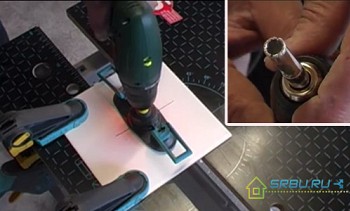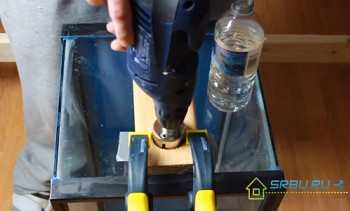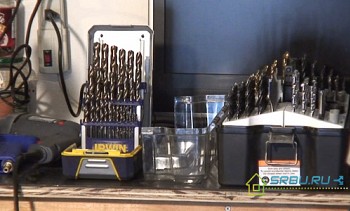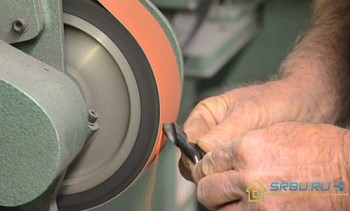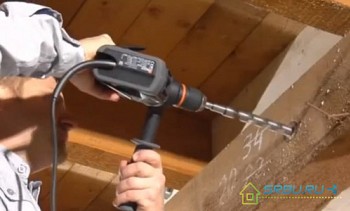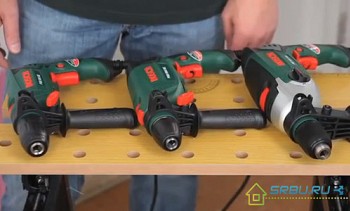When the walls in the bathroom and toilet shine with brand new tiles, it’s nice to take a look at them. But the repair is not finished yet - you need to hang the shelves and fix the mirror. But far from everyone knows how to drill ceramic tiles correctly in order to prevent accidental chips. Alas, fragile ceramics can be damaged very easily, and then a fine repair will go down the drain. In order not to rack your brains, where to get tiles instead of damaged ones, you need to know how to work with them. Read more about this later.
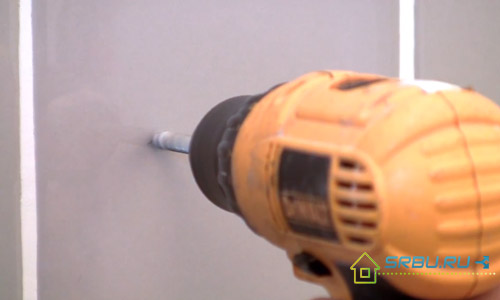
Content:
Basic principles for drilling tiles
The first step is to choose a drill. It should be neither shock nor high-speed, since tiles must be handled very carefully. So, for making holes in the tile, the following tools are suitable:
- Electric drill turned on at minimum speed;
- a cordless screwdriver with a maximum rotation speed of not more than 800-1000 rpm;
- low-speed, cordless screwdriver.
And drill for tile must be taken special. They are not at all like a tool for drilling wooden, concrete and metal surfaces. The principle of tile drilling is different - friction with abrasives. A diamond or drill bit has either an arrow-shaped shape or a crown shape. And tiles can be drilled with the so-called "ballerinas" - special devices with diameter adjustment.
When the necessary tool is prepared, you can begin to work.
In this case, it is necessary to take into account some points:
1. Do not allow overheating of either the drill or the tile itself. Otherwise, the top layer of the tile will become cracks that can crack the tile. To cool the working surface, it is enough to periodically water it.
2. Try to work out optimal pressure on the drill. It should be neither too weak nor too strong. In the first case, the hole cannot be drilled, and in the second, the tile may break.
3. The reverse mode for such an operation as drilling a tile is unacceptable. The drill should rotate slowly and only clockwise. Otherwise, the material will crack.
4. If you intend to drill holes in the seam between the tiles, be especially careful when drilling. The center of the hole should be in the middle of the seam. When you have to drill side by side with a seam, then, as a rule, the drill slides into the seam. There is no protective layer at the edge of the tile, and its piece breaks off.
Some advise to tilt or knock down the icing of the tile with any tool at the drilling site, we strongly do not recommend this. This is advice from Soviet literature. In the presence of modern drills, this procedure is absolutely unnecessary, because it is very easy to break a tile, but it is very difficult to replace it with a new one.
How to drill small holes for dowels
To hang a small shelf in the bathroom or in the kitchen, you often need to make a hole in the tile glued to the wall. In order for the shelf to hold firmly, it is necessary to make a sufficiently deep hole penetrating into the wall. A dowel made of nylon is then inserted into which a self-tapping screw is screwed.
As a rule, an electric drill is used for these purposes, and then the hole is modified puncher. The speed of rotation of the drill should be low.
What drill to choose for a tile
1. When drilling a tile, a diamond-coated tool showed itself best. It is quite expensive, and not everyone can afford it.And it makes no sense to buy it in order to make two or three holes. But a professional who has to drill a tile often, usually in the arsenal has several such drills of different diameters. In this case, they pay off quickly.
2. Lance-shaped lance drills are specifically designed for drilling ceramic tiles and reduce the risk of tile splitting. Due to the special sharpening, it has the shape of an arrow, which eliminates slipping at the beginning of work. Due to the sharp angle of the cutting edge, the area of contact surfaces is reduced. Because of this, you can work with a drill with less effort - which means that cracks on the tile are unlikely to appear.

Lance-shaped drills, higher with a victory tip, lower with diamond spraying.
3. If there’s absolutely nothing at hand, take a concrete drill made of hard alloy. It should be either very well ground, or have a spray of victorious. Just remember - you should use this tool with extreme caution, since it is not designed for tiles, but has a completely different configuration.

Drill and drill bit for concrete.
We drill the tile in accordance with all the rules
Before you start drilling tile, with a marker that stands out well on its front surface, make marks in the right places. Keep in mind that the drill, while it has not yet penetrated into the tile, usually tries to insidiously slip on its smooth surface. To prevent this, glue a piece of plaster or paper tape at the drilling site.
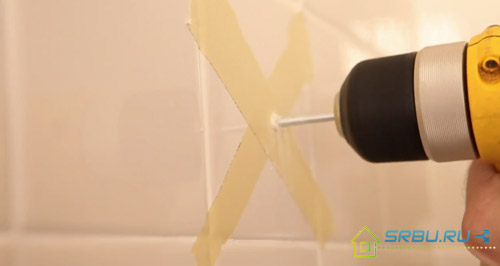
At the very beginning, when the surface of the tile is to be drilled, the drill speed is set to a minimum. Once the drill is deep enough into the tile, you can add speed. However, you don’t need to be very zealous - you should work slowly and carefully. Remember that the shock mode of a drill or hammer must be strictly prohibited. Otherwise, it will be sad to collect pieces of tile.
If you need to drill a part of the wall for fixing the dowel, we work in two stages. First, drill through the tile with the appropriate tool. Then turn off the drill to replace the drill with one that is more suitable for a concrete surface. There is already a shock mode of a drill or perforator does not hurt - otherwise hard concrete does not break.
Video: How and what to drill ceramic tiles
How to make a large hole for an outlet or pipe
When the mixer changes, an electrical outlet is put in, or a new pipe is brought in, it becomes necessary to make a neat large hole of the corresponding diameter. At the same time, many are wondering: with which drill to drill ceramic tiles? There are two options:
- Hard alloy crown.
- A circular drill type ballerina.
Which is better: crown or ballerina
1. There are special cutting crowns with diamond spraying. It is quite expensive, and it does not always make sense to purchase it. When using this tool, do not forget to wet it with water. Do not make drill revolutions high - crowns are afraid of overheating.

Varieties of diamond coated crowns.
2. However, for one-time work, you can use a cheaper option. This is a crown having teeth from defeated. Its minus is that after 20 holes the crown can be safely thrown away - its resource will be exhausted. The diameters of the crowns are up to 15 centimeters, which is enough even for an opening for a sewer pipe. But you need to work with a crown with teeth very carefully, without making sudden movements, while the edges of the hole will still be chipped and uneven.

Crown with victorious teeth for drilling on concrete.
3. A ballerina is a drill in the form of a spear or cylinder, in which a bracket is fixed on the tail. In it, in turn, is another spear-shaped drill. Moving it along the bracket, you can vary the diameter of the resulting hole. It is better if the average center drill is not cylindrical - this is an unsuccessful option, but hexagonal.A ballerina is inexpensive, not more than 300 rubles, so every home master can buy it.

And here is the ballerina
We drill the tile in accordance with all the rules
Before drilling, the tile is marked and, if necessary, a piece of paper tape or adhesive is glued to the place of drilling. In addition, to make it easier to start, you can cut the stencil from fiberboard or plywood, then press it tightly to the tile to start drilling. If you need to drill a tile that has not yet been glued to the wall, then it must be laid on a flat surface. We start drilling at low speeds without pressing hard on the snap. The crown itself should be tried to be held parallel to the tile, so that when the drill drowns in the tile, it starts to bite into the tile evenly around the entire circumference. Sudden movements from side to side are not permissible.

Start drilling with a crown and diamond spraying.
If you have to work with a diamond crown, then you can quickly make a hole, working at high speeds. Unfortunately, heating cannot be avoided. And it is fraught with burning (burning) of diamond grains on the spraying, which affects the quality of the tool. Therefore, if you want to work quickly, be sure to put water next to you to wet the tool. Or you can drill dry, but at low speeds.
However, if the crown does not have a diamond coating, it is better to use the “wet” method of drilling. This is especially true for tiles coated with glass glaze. And for an ordinary tile, this option is preferable - and the drill at the same time lasts longer, and dust does not form. In addition, when the instrument is wetted with water, the hole can be made much faster.

After a little bit of wetting, wet with water.

We continue to drill, periodically wetting the surface of the tile with water.

After the hole is ready you will have just such a washer.
If you have to work as a ballerina, first we expose the desired diameter on it. The distance between the central and side drills is set two times less than the desired hole diameter. Then in the intended place we drill at low speeds. We hold the tile tight so that flying fragments of drilling products do not hurt anyone. Safety glasses are a necessary precaution. Hold the drill straight, do not tilt it. A tripod does not hurt to secure it.
So, how to drill a tile correctly, you are now informed. As you can see, this is not particularly difficult. The main thing is not to rush, to work carefully and carefully, using a special tool. And store water for wetting.


